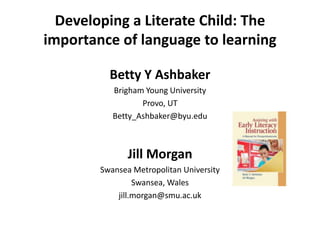
Developing a Literate Child: The Importance of Language to Learning
- 1. Developing a Literate Child: The importance of language to learning Betty Y Ashbaker Brigham Young University Provo, UT Betty_Ashbaker@byu.edu Jill Morgan Swansea Metropolitan University Swansea, Wales jill.morgan@smu.ac.uk
- 2. Who are you? What do you do? Where do you work? How long have you been in your job?
- 4. Reading System of complex cognitive processes that requires recognizing and making sense of written symbols that represent speech. Readers must decode the symbol system and grasp the writer’s intended meaning.
- 9. What We Know Most struggling 1st graders do not catch up. Number of struggling readers grades 4-12 More than 8 million Number of high school student who drop out daily More than 3,000 Students in the lowest 25% are __?__ times more likely to drop out of high school 20 times. What is the greatest academic concern? READING
- 13. How many children are read to by their parents every day? 45% of children below age 3 years 56% of children age 3 to 5 years This means that approximately half of all children under the age of 5 are not read to by their parents on a daily basis.
- 14. Paraprofessional’s Role To assist students in accessing as much of the prescribed curriculum as possible, To help them perform to their maximum potential, according to their abilities. To use effective instruction techniques.
- 15. Establish a business-like atmosphere, where it is obvious that learning takes priority. Your attitude shows that learning is an exciting and challenging activity that you are eager to engage in with your students. Such an attitude helps to keep students on-task and reduces the likelihood of inappropriate behavior.
- 17. Reading recoveryPhonics Whole language
- 18. The problem isn’t that we don’t know what to do,it is that we don’t do what we know (Heward, 2003).
- 19. Here’s What We Must Do ! Use explicit instructional strategies Address specific strengths and weaknesses Address the 5 essential components of reading Use coordinated instructional sequences Give ample practice with aligned student materials
- 20. 5 Big Ideas in Early Literacy identified by the National Reading Panel: Phonemic Awareness Alphabetic Principle Accuracy and Fluency Vocabulary Comprehension
- 21. Phonemic Awareness Phoneme Isolation Phoneme Identification Phoneme Categorization Onset and Rime
- 22. The Alphabetic Principle Naming letters Supporting early understanding of alphabetic principles
- 24. Write messages to the child on small flip notebooks. These can be made from scrap paper stapled together along one edge. Then encourage the child to send messages back – and tell you what they have written.
- 26. Gaining Reading Skills and Reading Fluency
- 27. Phonologic Awareness Important to build phonological knowledge and skill Syllables Rhymes
- 28. Basic Awareness We use picture books with babies to teach them to focus their attention. We encourage toddlers to turn the pages – only one at a time! We make sure that the book is turned the right way up, and that we start at the front of the book, not the back. We point to and follow the words with our finger as we read them. It helps them to learn that print is read from left to right in English. We talk to children as we read to them: Look – here’s a picture of a ball. And this word says ‘Ball.’to help them understand that words represent and are linked to the objects pictured on the page, We use the vocabulary associated with reading – referring to pages, words, sentences, etc.
- 29. Phonics Awareness Assisting in teaching phonics Important concepts Building Phonics Awareness The sequence of instruction Learning sounds
- 30. Instruction for at-risk readers Explicit, intensive instruction Make the invisible visible Modeling responding correction, reinforcement Maximize learning opportunities Must exceed the typical gains (lowest must make greatest gains) Supportive Systematic and sequential instruction More feedback on correct/incorrect responses More positive reinforcement
- 31. Building Vocabulary and Comprehension: Oral Vocabulary Development The most common words Vocabulary growth during school years
- 32. According to The Reading Teachers Book of Liststhe first 25 words make up about one-third of all printed material in English, and the first 100 make up about one-half of all written material.
- 33. Supporting the Building of Vocabulary Teach word learning strategies Compound words Prefixes and suffixes
- 34. Reading Comprehension Supporting developing reading comprehension Supporting critical thinking Reading and understanding Impairments in communication Barking at print My role in building vocabulary and reading comprehension
- 35. The Teaching and Learning Cycle
- 36. The Teaching and Learning Cycle (Continued) Teamwork and Self-Evaluation © Ashbaker, B.Y. & Morgan, J 2010
- 37. What are the basic components of effective instruction? A check for prerequisite skills, The presentation of new content in small steps, integrated with Guided practice, Independent practice, Reviews. practice
- 39. Managing Tutoring to Alone we can do so little Together we can do so much Helen Keller
- 40. Resources Paraprofessionals in the Classroom Assisting with Early Literacy Instruction: A Manual for Paraprofessionals Supporting and Supervising your Teaching Assistant A Teacher's Guide to Working With Paraeducators and Other Classroom Aides Also Available from Pearson Allyn & Bacon, ASCD, Continnumor through http://www. Amazon.com Contact the authors at: Betty_Ashbaker@byu.edu jill.morgan@smu.ac.uk
